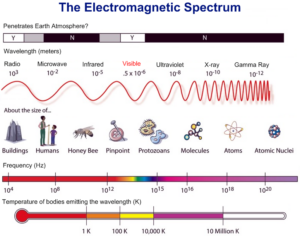The Greenhouse Effect Explained
The author of today’s post, Bill Chameides, is Chief Scientist at Environmental Defense.
Last week we got a request to explain the Greenhouse Effect. Here goes.
The Greenhouse Effect is the process by which an atmosphere holds heat around a planet. The story of how this works begins with a discussion of light.
The light that we can see with our eyes is just a small part of the full spectrum of light that occurs in nature. We call this the electromagnetic spectrum because light is a composite of interacting electric and magnetic force fields. The spectrum extends from low energy microwaves and infrared light to the visible part of the spectrum (red, orange, yellow, green, blue, and violet), and then to more energetic forms of light such as ultraviolet and x-rays.
Adapted from NASA diagram. Click to enlarge.
It turns out that all objects with a temperature above absolute zero radiate light. The amount and kind of light that is radiated depends upon the object’s temperature. The higher the temperature, the more light is radiated, and the more energetic the light. That’s why blacksmiths heating up a horseshoe first see it begin to glow red, and then white as it gets hotter.
The Sun’s surface, which has an average temperature of 10,000 degrees Fahrenheit (5810 degrees Kelvin), primarily radiates visible light. That’s why we can see sunlight. The surface of the Earth has an average temperature of 60 degrees Fahrenheit (288 degrees Kelvin), so it radiates in the infrared part of the spectrum. We can’t see the light the Earth radiates, but we can measure it with modern instrumentation.
The temperature of an object is determined by a balance between incoming and outgoing energy. For the Earth, the incoming energy is the absorbed light from the Sun, and the outgoing energy is the infrared light the Earth radiates out to space. In the absence of an atmosphere with its Greenhouse Effect, that balance would lead to very cold temperatures – well below the freezing point of water.
Fortunately the Earth does have an atmosphere, and that atmosphere contains some molecules with three or more atoms – for example, water (H2O), carbon dioxide (CO2), methane (CH4), and nitrous oxide (N2O). These molecules are called “greenhouse gases” because they have a very special property. They do not absorb the visible light from the sun, but they do absorb the infrared light radiated by the Earth’s surface.
If greenhouse gases were not in the atmosphere, all the infrared light radiated by the Earth would go back out to space, leaving the Earth too cold for life. But the greenhouse gas molecules absorb the infrared light, and then re-radiate some of it back to the Earth’s surface. This makes the surface hotter so it radiates more light, thus establishing an equilibrium at a higher temperature. This process is known as the Greenhouse Effect.
The Greenhouse Effect can be proven in many different ways. For a history of the science, see my previous post, “A 175-year-old Puzzle“. More proof can be found by studying Mars and Venus. Mars is very cold, has no appreciable atmosphere, and its temperature can be explained without invoking a Greenhouse Effect. Venus is extremely hot, has a thick atmosphere heavy with carbon dioxide, and only a very strong Greenhouse Effect can account for its high temperatures.
The Greenhouse Effect is a good thing – we wouldn’t be here without it. The problem of global warming has arisen because humans are artificially increasing the concentration of greenhouse gases in the atmosphere. This creates what’s called an Enhanced Greenhouse Effect.
The atmosphere with its greenhouse gases is the Earth’s blanket. We do need some blanket over us or we’d freeze to death, but when the blanket gets too thick, we also have a problem. Excess greenhouse gas emissions and deforestation are starting to make our blanket dangerously too thick. We can’t thin it out – greenhouse gases can stay in the atmosphere for hundreds of years. But we can – and must – stop it from getting any thicker.












One Comment
Greenhouse effect is the gradual warming of the air surrounding the earth as a result of heat being trapped by environmental pollution.